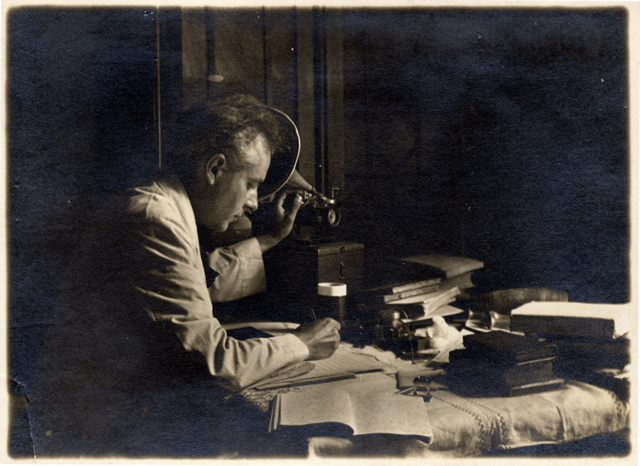Introduction
Folksong arrangements hold a significant place in Béla Bartók’s oeuvre: more than a third of his compositions are folksong arrangements or contain movements built on folk music material. Moreover, the genre is not confined to certain style periods; it is present throughout Bartók’s career. His first endeavors in writing folksong arrangements, towards the end of 1904, followed shortly Bartók’s first folksong transcriptions during the summer of that year. Admittedly, the last major sets of folksong arrangements, the Forty-Four Duos for two violins and the Székely Foksongs were written at the beginning of the 1930s, but Bartók composed a few smaller pieces afterward. One of his last works, The Husband’s Lament also uses a folk song as a theme and there is a set of three folksong arrangements among the unfinished compositions of his final years.
As a rule, Bartók expressed the content of these compositions in explicit titles, such as Eight Hungarian Folk Songs, Romanian Folk Dances, or Slovak Folk Songs. Occasionally, he chose unique titles for some of his series, as For Children, Improvisations, or Village Scenes. These, however, are invariably followed by subtitles explaining the nature and content of the composition. Beyond the title, Bartók often provided the sources and pertinent data of the melodies in the scores of the folksong arrangements, including, on three occasions, the melodies themselves. In some of the publications of his folk music collections, he listed the melodies he had arranged in his compositions. Indeed, most of the melodies can be located in these publications. Yet, there is a great number of melodies that was never published and has to be sought out in his manuscript folk music collections.
Most of the melodies selected for arrangement come from Bartók’s own collections. Although he chose melodies from printed sources at the beginning of his career, Bartók preferred, from 1910 on, to arrange melodies which he had heard in the field or on sound recording. The arrangements of Slovak, Romanian, Ruthenian, Serbian and Arab melodies are exclusively from his own collections. Few exceptions occur in the Hungarian material but Bartók either had transcribed these melodies from the recordings, or at least corrected the transcriptions of other collectors.
The list of Bartók’s folksong arrangements
It was Bartók himself who compiled the first list of his folksong arrangements. The list, which survives among his papers, itemizes all but one of the compositions published until 1933 that contain folk songs, alongside the number of the songs used in each composition.[1] Since the last published composition on the list appeared in print in 1933 and the last item, Székely Folk Songs, published in 1938, was still in manuscript when Bartók added it, he must have compiled the list between 1934 and 1938.
One of the two abbreviations appearing in the first column is unambiguous, denoting vocal compositions (v=vokális [vocal]). The letter “h,” however, might indicate either hangszeres [instrumental] or hegedű [violin] pieces. In either case, Bartók left one title unmarked (since the Three Hungarian Folk Songs from Csík use instrumental melodies, the 44 Duos are for two violins). Somfai’s interpretation, according to which the letter “h” means works written for violin and piano, seems to be the most feasible, even though the Sonatina and the Romanian Folk Dances, both marked with “h,” were originally written for the piano alone, and the pieces Bartók arranged with Tivadar Országh for violin and piano (Hungarian Folk Songs, transcription of selected pieces from the series For Children) were not included in the list. The second column shows the number of melodies used in the given work; in the third column Bartók registered the short version of the works’ Hungarian titles. The following transcription of the list is completed, in brackets, with the English title and composition number in Somfai’s list of works.[2]
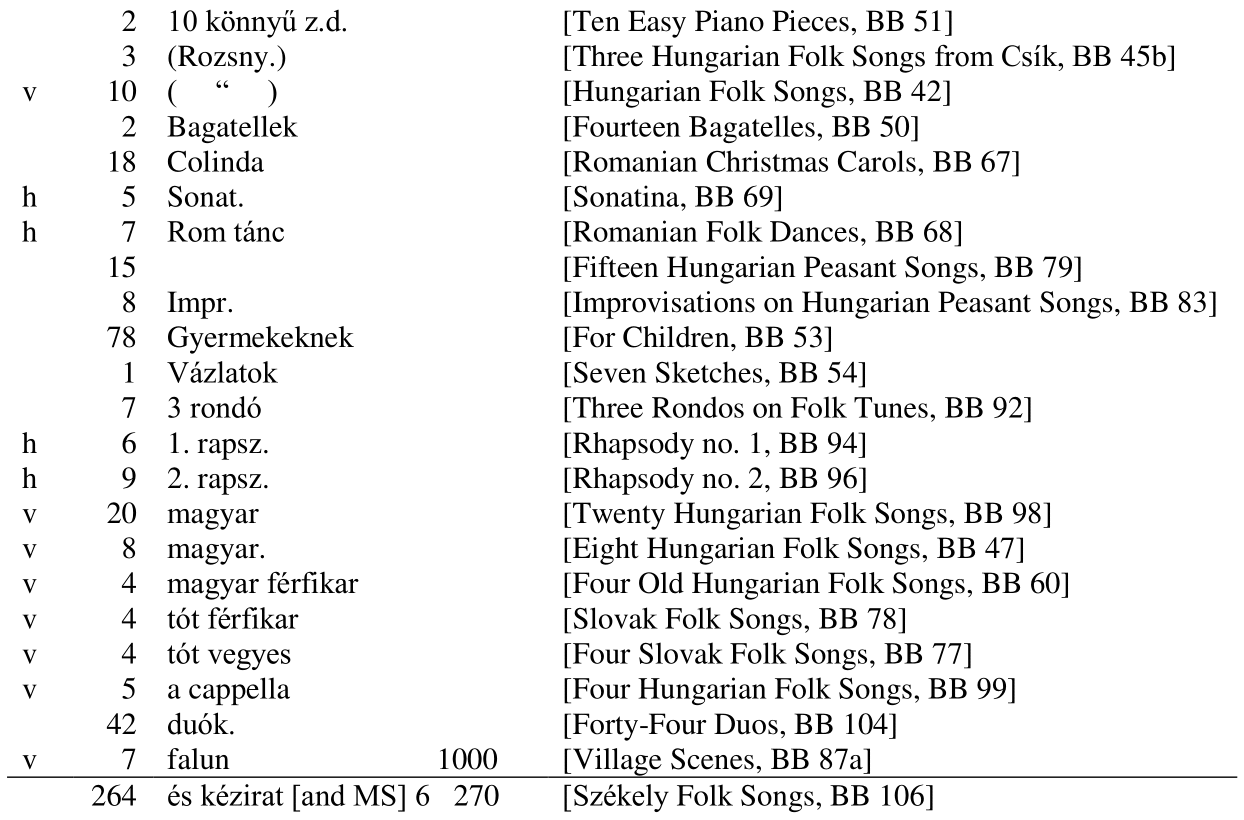
This list needs some clarification, primarily in respect to the number of melodies used in certain compositions. In general, Bartók recalled these numbers correctly; for several titles, however, he noted fewer melodies than their actual number. In the Hungarian Folk Songs (BB 42), nos. 3 and 4 (in the first edition) present two versions of each melody but Bartók counted them only once. He also noted eighteen melodies at the Romanian Christmas Carols, yet the series contain twenty pieces: the reason for Bartók’s number certainly is that the ninth and tenth pieces of the first series and the sixth and seventh pieces of the second series are again close variants of each other and, in fact, are given the same group number in Bartók’s folk music collection. In the series For Children, Bartók gave the number of melodies used as 78, yet the actual number in the original series is 85 and in the revised edition, 79. He also erred in giving the number as nine in the Second Rhapsody as he, in fact, used ten melodies in that composition. Finally, he left out from the list one work, the First Term at the Piano which also contains folksong arrangements. It is of lesser importance that Bartók made a slight mistake when adding up the numbers of melodies used in his compositions: the correct sum is 265, or 271, if we count the work in manuscript. The significance of the number (1000) on the right above the line separating the column of numbers and their sum is not clear; it might have been written there on another occasion, possibly even before Bartók drew Holzhorn up the list.
To reflect the true volume of folk songs arranged in Bartók’s compositions, this compilation has to be expanded, above all with the titles written after 1938, but also with earlier compositions and with works that remained unpublished in Bartók’s lifetime now available for study and performance.
Bartók left out from the list his earliest folksong arrangement, Székely Folk Song (BB 34) that was also the first such work to appear in print.[3] While it was later discovered that the folk song arranged in this work was “a fragment known all over the country”[4] and also popular among the people of the neighboring countries,[5] one can still argue that it belongs on the list because it was one of the first melodies Bartók ever collected (from the servant maid Lidi Dósa in 1904),[6] and notwithstanding its shortcomings, he handled it as genuine folkloristic data, including it in his folk music collection and even in the representative melodies illustrating his book, Hungarian Folk Music.
The arrangements that were published posthumously either partly or in their entirety are also included in the catalog: the second series of Hungarian Folk Songs (BB 43), the Two Hungarian Folk Songs (BB 44), the Four Slovak Folk Songs (BB 46), the Two Romanian Folk Songsfor women’s chorus (BB 57), the Slovak Folk Song “Krutí Tono vretena” (BB 73), and The Husband’s Lament(BB 125). Of the completed folksong arrangements, still in manuscript, is also present Nine Romanian Folk Songs for voice and piano (BB 65). Excluded are some unfinished or fragmentary compositions. The Hungarian Folk Songs, first series (BB 37), were left out not only because the text of the third song and the second part of the fourth are missing, but also because it turned out that all of them are popular art songs, even those two which Bartók collected in Gömör County. Also excluded are the three songs Bartók had intended for his Hungarian Folk Songs (BB 42) but later replaced with others. The unfinished Three Ukrainian Folk Songs(BB 126) are also omitted. The melodies which Bartók considered using but cut out from the final form of two of his works, from the second rondo of the Three Rondos,[7] and from the second movement of the First Rhapsody,[8] are also left out of consideration here.
Bartók designated four pieces as “folk songs” in his First Term at the Piano (pieces taken from the Piano School he had compiled with Sándor Reschofsky): nos. 7, 10, 13, and 15. No folk music analogy could be found for the first one of these; nevertheless, we included it in the catalog, since in his other works Bartók applied this title consistently for folk melodies. On the other hand, there is a fifth piece in the First Term at the Piano that has to be counted in the catalog: no. 16 (Peasant Dance). The first two lines of this melody correspond almost exactly with that of a melody, sung without words, collected by Vikár and transcribed from the phonograph cylinder by Bartók (see L 122).
In establishing the number of folk songs contained in the Mikrokosmos, one is faced with two contradictory statements of Bartók. One of them is from Benjamin Suchoff’s book, Guide to the Mikrokosmos of Béla Bartók,[9] where information given to Ann Chenée by the composer is quoted along with his remarks published in the score of the work. According to Mrs. Chenée’s notes, Bartók stated that nos. 83, 100, and 115 were folksong arrangements. However, in an interview given in 1940 to Miklós Szentjóbi, who asked Bartók whether the pieces in Bulgarian rhythm (thus no. 115 as well) contain genuine folk songs, Bartók clarified the misconception: “No, these are not Bulgarian folk songs, rather, they have the so called Bulgarian rhythm; they are original compositions, no folk melody is to be found in them. (In the entire Mikrokosmos, there are only three pieces that are folksong arrangements.)”[10] Although this number has to be rectified, because there are actually four in the Mikrokosmos that have corresponding folk sources, none of these are the same as the numbers quoted, probably as a result of some misunderstanding, by Suchoff. In any event, our list contains only those numbers of the Mikrokosmos for which adequate sources were found.
Although in his list of arranged folk songs, Bartók rather underestimated the number of melodies used in his compositions, he seems to have done the opposite in the case of Székely Folk Songs which consists of six movements, but the third and fifth movements are built on the same folk material. If Bartók did not err giving the number of melodies in the work as six, then the sixth melody must be the opening melody-fragment: Jaj de sokszor megbántottál. The origin of this melody, however, has not yet been traced.
When Bartók revised two of his earlier folksong arrangement series for a second edition, he omitted some pieces from both of them. Thus the fifth number of the first edition of the Hungarian Folk Songs (BB 42) was omitted from the 1933 second edition because in the meantime Zoltán Kodály discovered that it was Elemér Szentirmay’s composition from the play Öregbéres.[11] From the For Children, six pieces were cut at the 1945 revision, partly for the same reason but also because two of the pieces (book 4, nos. 33–34) are not Bartók’s compositions but those of Emma Sándor-Kodály.[12] Nevertheless, our catalog lists the numbers of the first editions of these works because these are still in circulation, and because the first conception of these works may also be of interest for scholars.
Some melodies occur in more than one composition but their source is usually the same. We have numbered each melody only once.
The table below summarizes the number of songs contained in each composition. The bracketed number shows the actual number, in case some of the melodies were accounted for in a different composition.

Types of sources
Field-books. Bartók carried small-format music notebooks on his folksong collecting trips. After some investigation of the available material, he notated the melodies worthy of collecting in these field books. Initially, he also wrote down the texts of the songs alongside the melodies (facsimile no. 1); since, however, the texts claimed too much space in the music books, he soon started to use separate notebooks for this purpose and he noted in the music books only the refrain lines or the words difficult to understand (facsimile no. 2). As he said in one of his essays, he spent about 5–8 minutes on average in transcribing a song on the spot;[13] then he recorded it with the phonograph. Alternatively, he deemed the field notation to be sufficient and did not make a recording: in these cases, the field notation is the only source for the melody’s further manifestations.
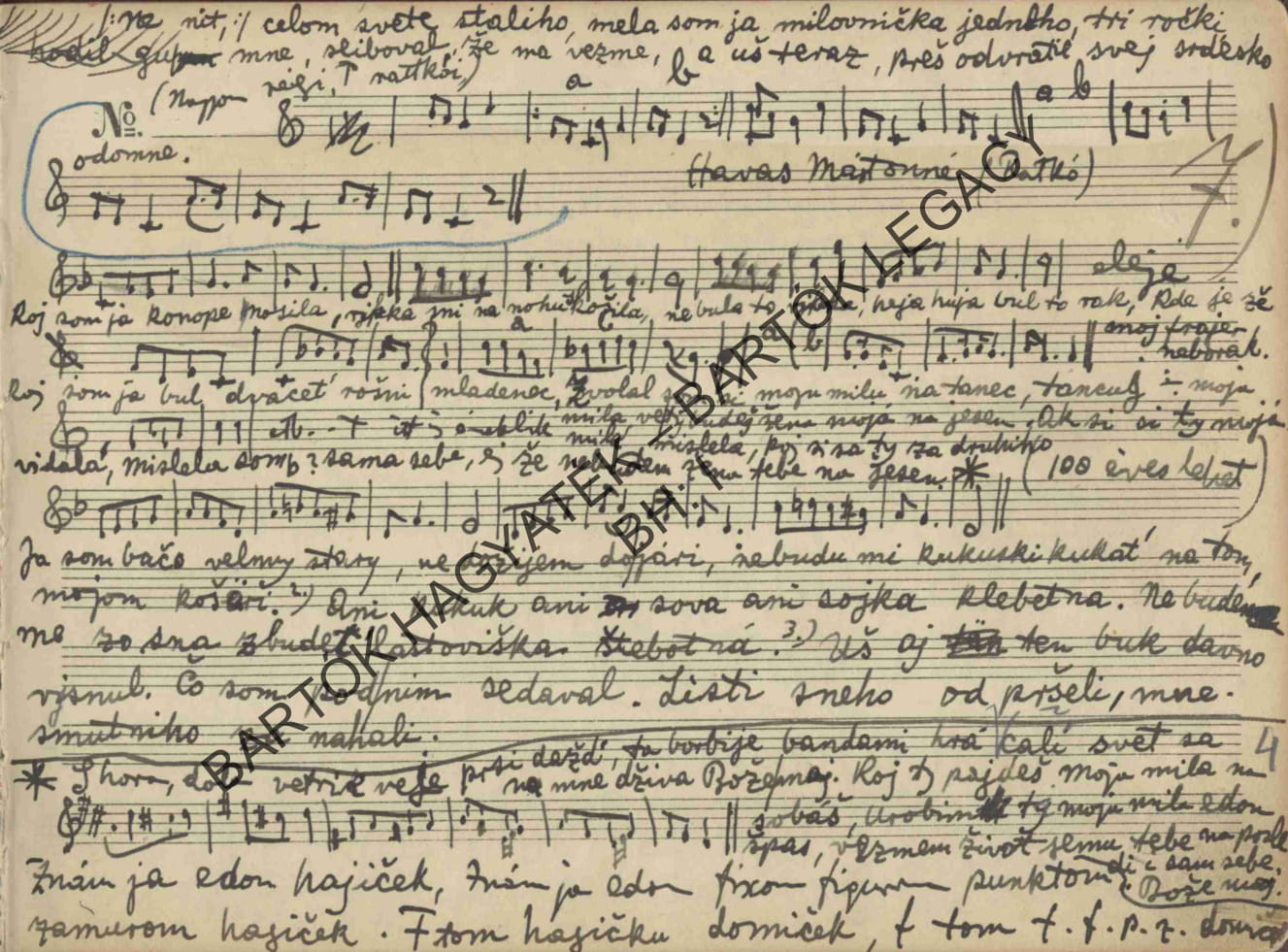

More often, however, he also made phonograph recordings of the melodies.[14] The use of the phonograph was introduced into ethnographic field work in the late nineteenth century because of its evident advantages over field notation. Not only does a sound recording register qualities of the musical performance difficult or impossible to render in writing, but it gives opportunity to repeated examination, therefore to a more minute observation of the material as well. In Hungary, Béla Vikár was the first to employ the phonograph in 1896; Bartók started to collect with it in 1906. Nevertheless, he shared Kodály’s view that the sound recording cannot supersede the field notation since the performer might err on the recording and only the field notation makes it possible to catch and correct those mistakes.[15] If there was no substantial difference between field notation and sound recording, Bartók entered his corrections from the recording directly into the field book. The corrections are well distinguishable because he used a pen in transcribing and made revisions in pencil.
There are sixteen field books among Bartók’s papers, now kept in the collection of the Budapest Bartók Archives. They are of oblong format, ca. 128x171, or 131x184 mm, containing 45–50 pages and ten staves per page. Their numbering, originating partly from Bartók himself, is the following: M. (Magyar = Hungarian) I, M.II, M.III, M.IV, M.V., M.VI; R. (Román = Romanian) I, R.II; T. (Tót = Slovak) I, T.II, T.III; IV, V, VI, VII and VIII. The complete analysis of these books has not yet been accomplished. All we know is that they were used between 1905 and 1917 (except for no. VIII which also contains notations from 1932) and that the books marked M.I–V contain only Hungarian, R.I only Romanian, and T. I–II only Slovak material, while the others have material of mixed origin—that is, they have Hungarian, Romanian, Slovak, and Ruthenian melodies. Not always consistently, but with ever more precision over the years, Bartók also noted in the field books the place and time of the notation, and the name and age of the performer.[16]
Transcriptions from the phonograph cylinders. When collecting instrumental melodies, “the secure knowledge of the player makes the field notation superfluous”[17] —that is, the performer makes relatively few mistakes, consequently, the recordings are reliable and there is no need for the control of the field notation. In these cases, the transcription from the recording constitutes the first written form of the melody. Bartók used for this purpose large-format, 347x265 mm music paper, containing 10, 16, 18, 20, 24, or 30 staves. Occasionally, he wrote the transcriptions of phonograms containing instrumental music in the field books, as the shepherd’s flute melodies from Gyergyótekerőpatak arranged in the Three Hungarian Melodies from Csík, or the melody of no. 42 of the For Children series, recorded in Felsőiregh. These, however, are still sporadic recordings of instrumental music from Bartók’s collecting trips (facsimile no. 3).
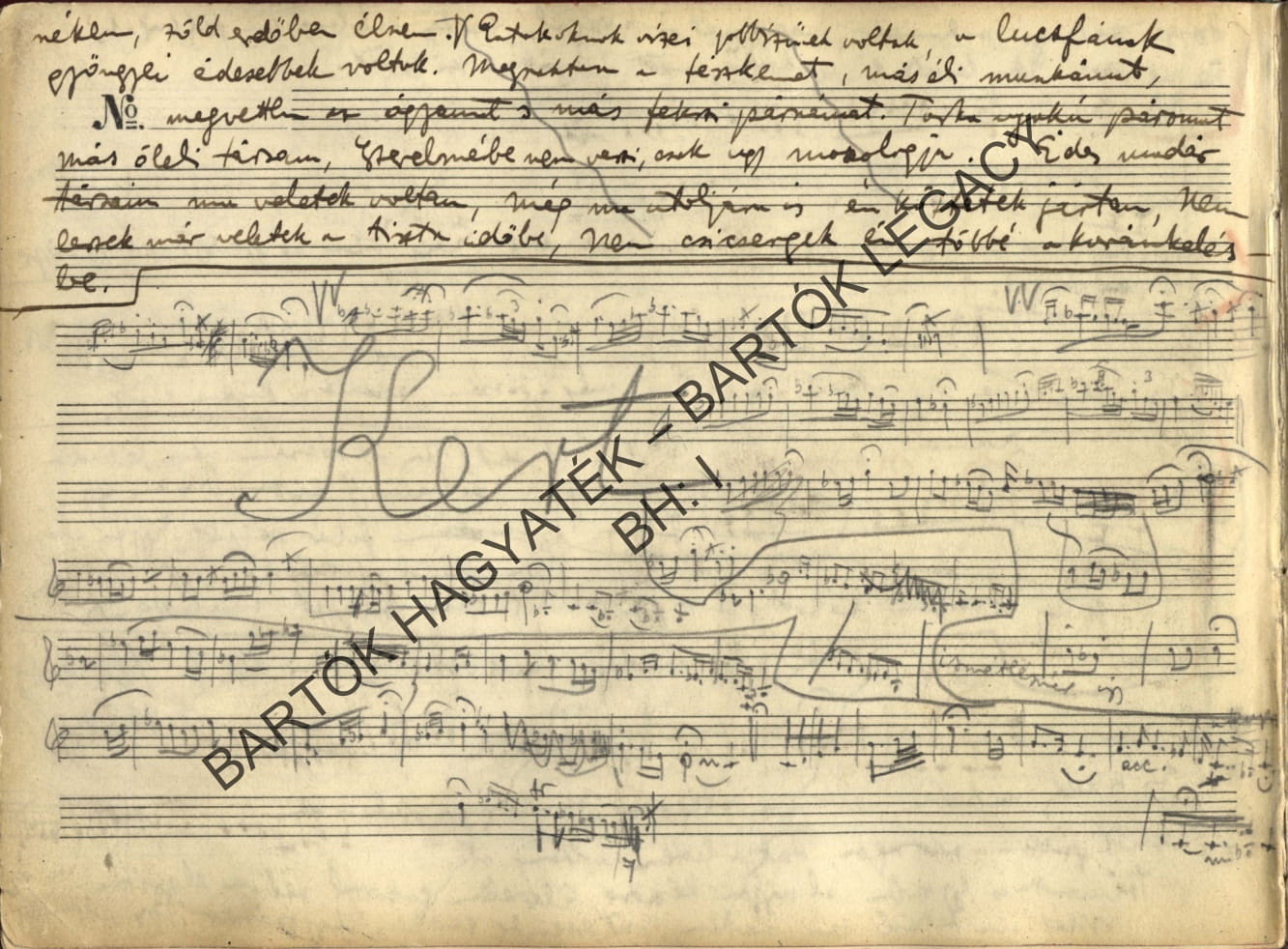
In the Budapest Bartók Archives, there are 164 sheets of music with Bartók’s first transcriptions of recorded instrumental folk music. Four of these pages are blank and a few of them also contain vocal music collected in Biskra and surroundings, Algeria, in 1913. Most of the transcriptions are in pencil, yet Bartók preferred to cross out wrong notes rather than correct them by erasing. When transcribing multi-stanza melodies, he made a complete notation only of the first stanza. He did not write down the similar passages of the subsequent stanzas but the differing passages, notating them under the analogous parts of the first. For the recurring motives, he used letter symbols (x, y, z; a, b, c) instead of repeatedly writing them out (facsimile no. 4). At the end of the transcribed melodies, he often left instructions to the copyist, his wife, Márta Ziegler.

Master sheets. After the written form of a melody from the field notation and/or the sound recording was established, Bartók made, or had his wife make a fair copy of each melody on a separate sheet of paper; to facilitate later organization of the material, each vocal melody was transposed to have its final tone as g. This copy is the so called támlap,[18] or master sheet which contains, besides the melody and text, the differing details in rhythm and pitch of repeated performances or variant melodies. In addition, all the data pertaining to the performance are noted on the sheet: the number of the phonograph recording, the original tonus finalis, the place and date of the performance, the name and age of the performer. When preparing the material for systematization, Bartók introduced further data, attained by musical analysis, on the sheet, such as the number of melody lines, the number of syllables of a line, the symbol of the final pitch of each line and the range of the notes of the melody. Through these criteria, developed by Ilmari Krohn for arranging folk music collections, Bartók was able to discover relationships between songs and determine the various stylistic groups in the folk music of the Hungarians and the neighboring peoples.
Naturally, Bartók’s views about the objectives of folksong transcriptions did not remain constant during his career. Initially, he strove to record the permanent features of a melody, established through listening to repeated performances. This effort results in a relatively simple notation, similar to the field notations which take no heed of the accidental aspects of the performance. However, the melody goes through changes every time it is sung, from stanza to stanza, from performance to performance, and from performer to performer. The phonograph cylinder perpetuates particular performances, enabling the later scrutiny of the changes and variations in the rhythm, tempo, and ornamentation. Observing these evanescent aspects in a large number of melodies, generalizations can also be made about the typical features of folk performance. This recognition was one of the reasons Bartók revised his transcriptions and made them ever more elaborate. The master sheets of his collections show ample evidence of the various stages of his transcribing technique.
(1) The master sheets of the earliest type were prepared probably before 1910, immediately after the first collecting trips. Their characteristics are: no text under the music, no tempo marking, only the year of the collection is given, Bartók’s name is either missing or marked with his (at times rubber-stamped) initials.[19] Later, Bartók substituted these early master sheets with new ones, hence they can be found in Kodály’s collection rather than his own (facsimile no. 5).
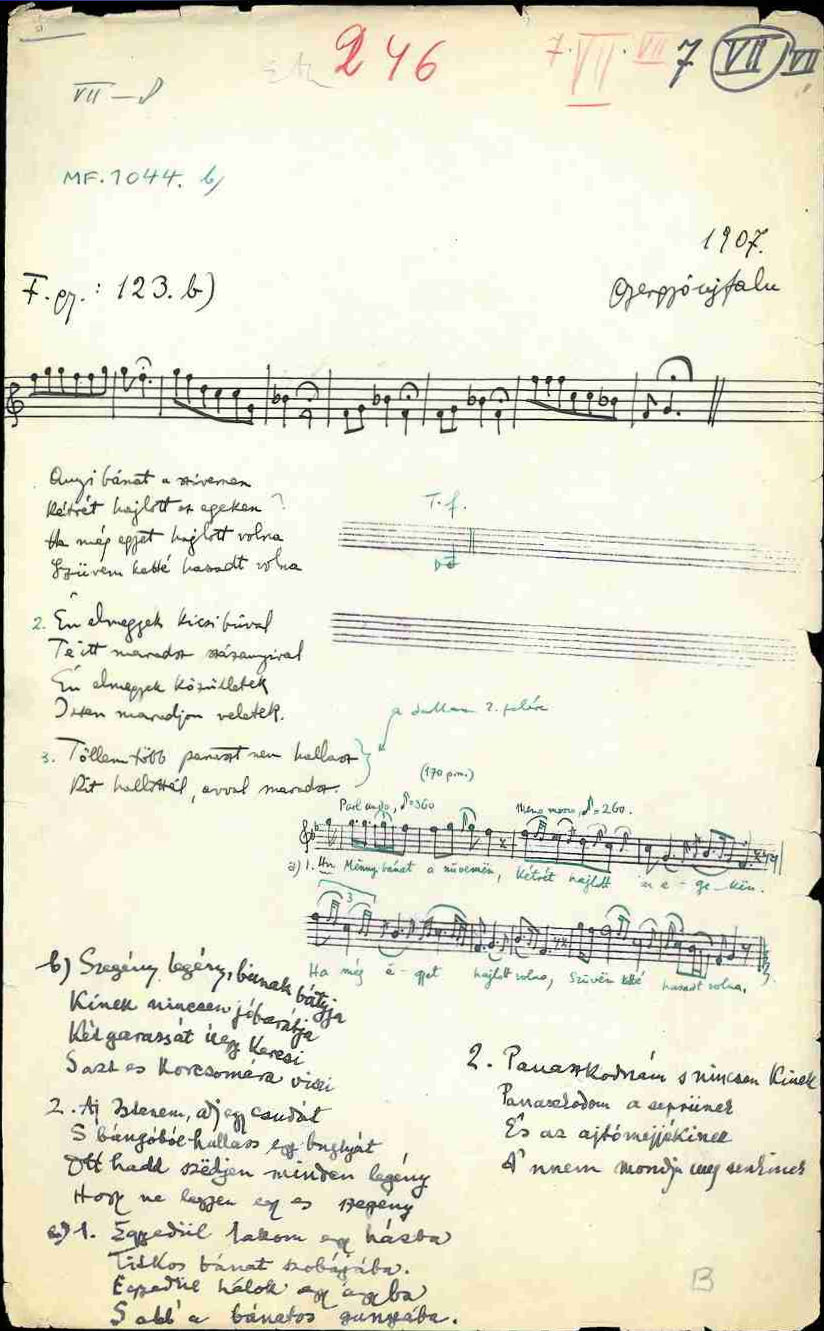
(2) A different type appeared in the 1910s when Bartók started to use sheets with three printed music staves and headings to fill in the data of collecting. The text is placed under the music, the tempo is usually indicated, as are the differing tones or rhythms of repeated performances (facsimile no. 6, facsimile no. 7, facsimile no. 8).
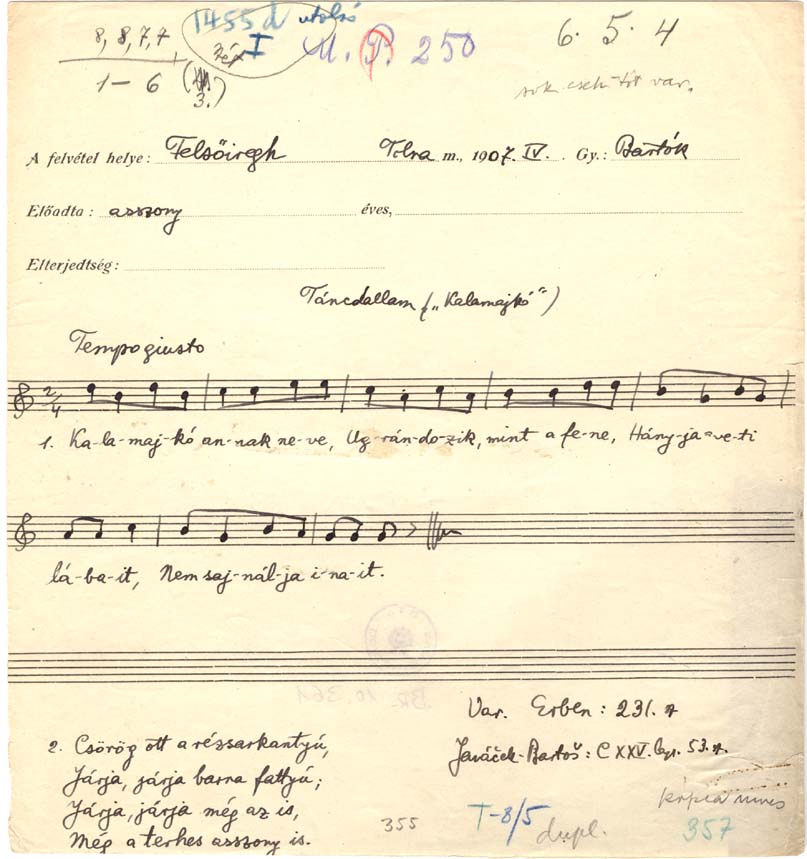
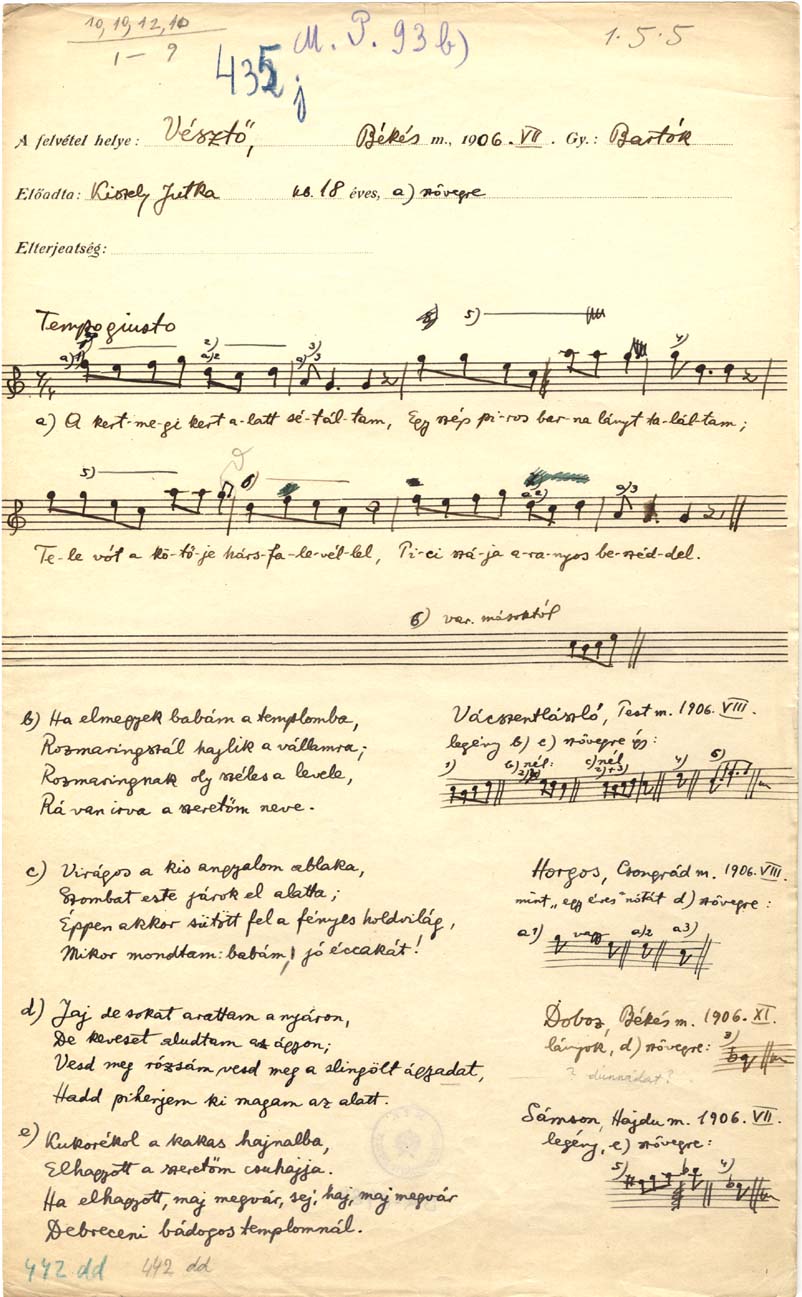
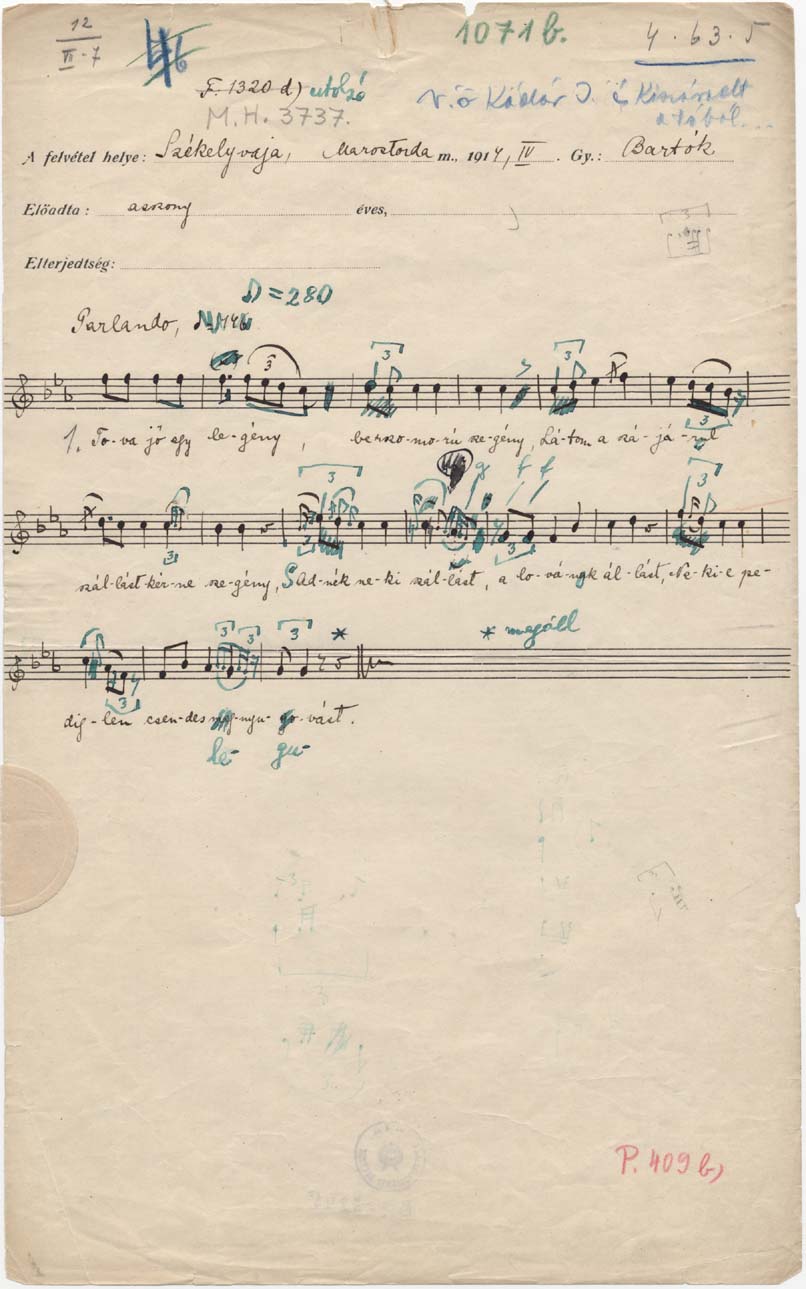
(3) Between 1918 and 1921, Bartók prepared new transcriptions of some of his earlier collections, especially of those from his trip in 1907 in Csík County and Felsőiregh (Somogy County). He needed the transcriptions to illustrate the articles he started to write about Hungarian folk music for foreign journals.[20] He was also working at the time on his book, The Hungarian Folk Song in which he published 320 melodies and their variants. In the new transcriptions, one can find more of the irregular rhythms of the rubato performance and of the ornamental notes between the main notes of the melody.[21] This type of master sheet also has a distinguished appearance because it generally consists of two parts glued together: the more recent upper part was written by Bartók, while the lower part with the text, usually in his wife’s handwriting, was kept from the earlier master sheet. Unlike on the earlier sheets, here the data of collections are registered on the right side, and the number of the phonogram (together with a new numbering), and the tonus finalisare on the left. Bartók’s name is either missing or was supplied at a later time (facsimile no. 9, facsimile no. 10, facsimile no. 11).
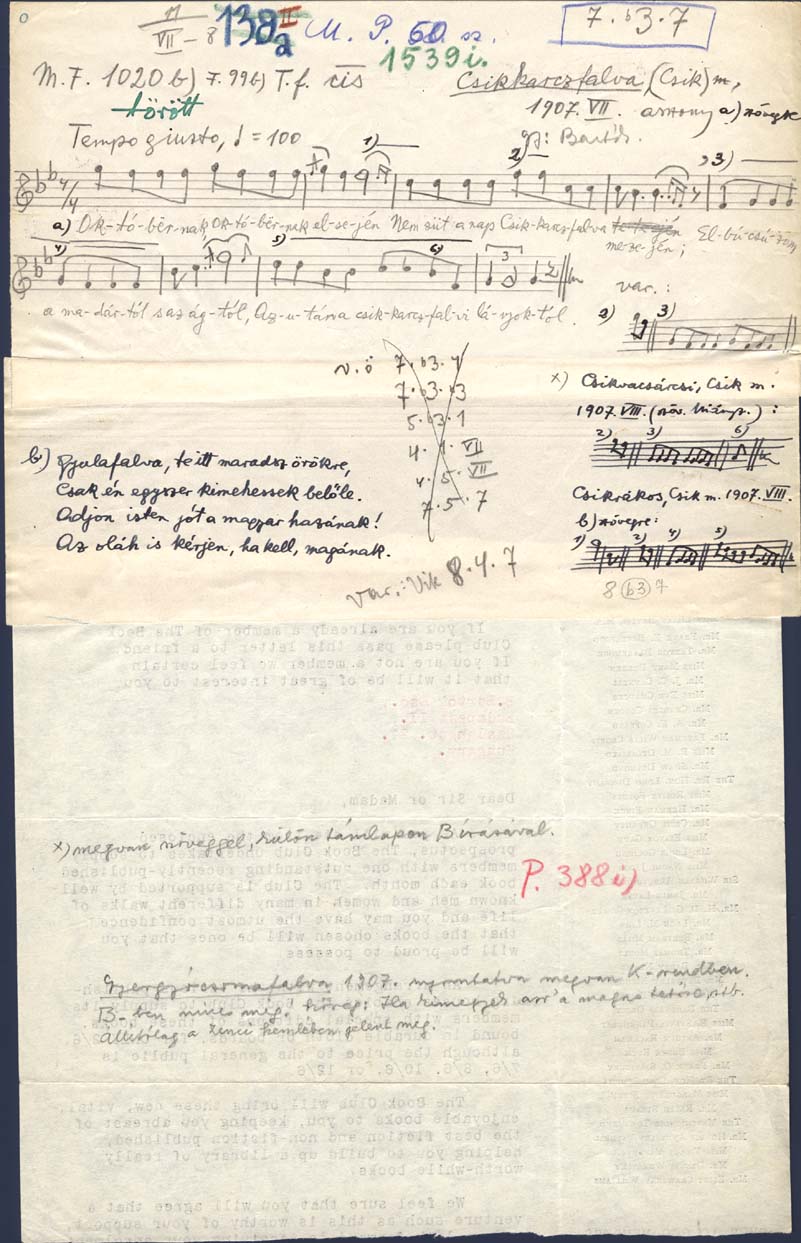
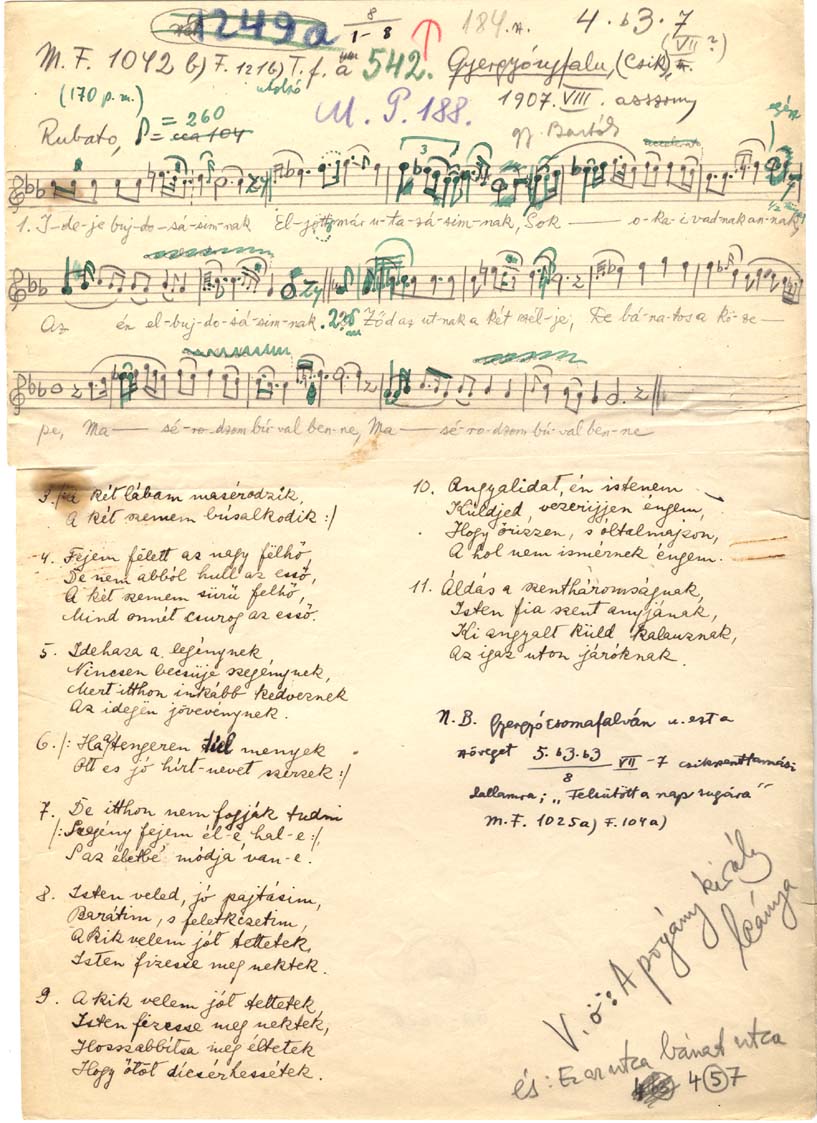
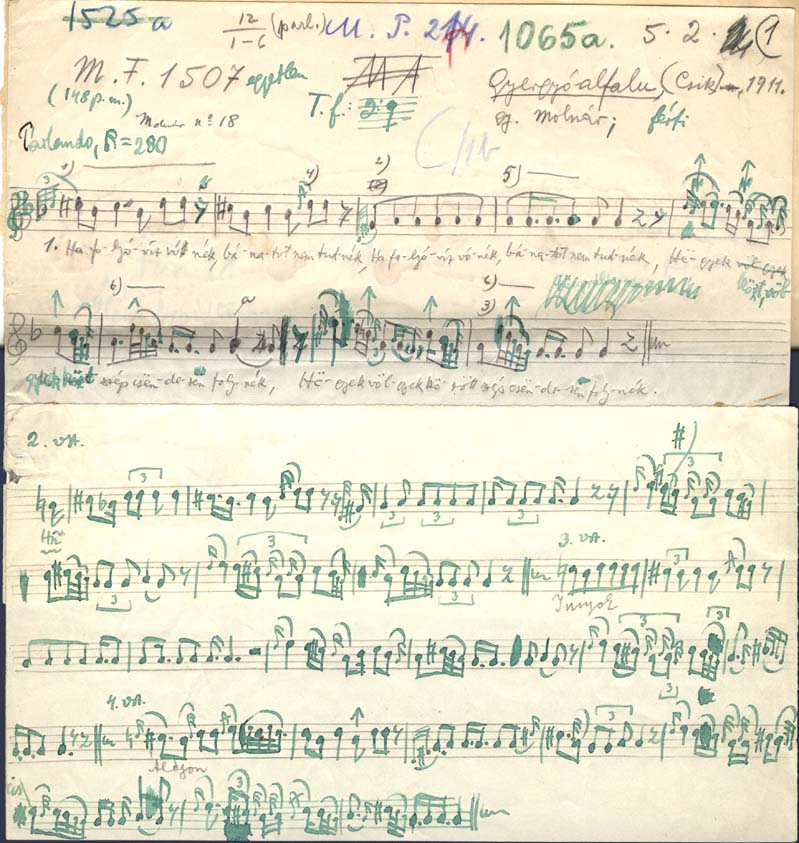
(4) From 1932 on, Bartók revised his entire Hungarian collection and, with the exception of the Maramureş volume, his entire Romanian collection as well. This decision was prompted by his recent discovery of what he called the Bulgarian rhythm and also because the Hungarian Academy of Sciences acquired a new phonograph. Bartók made the most of the opportunity to prepare his collection for publication with special attention to this rhythmical peculiarity. His corrections are in green ink, thus well distinguishable from the original transcription. If the changes were excessive, a new master sheet was prepared, this time on paper with four pre-printed staves, usually by one of Bartók’s colleagues, or occasionally, as in facsimile no. 12, by Bartók himself.
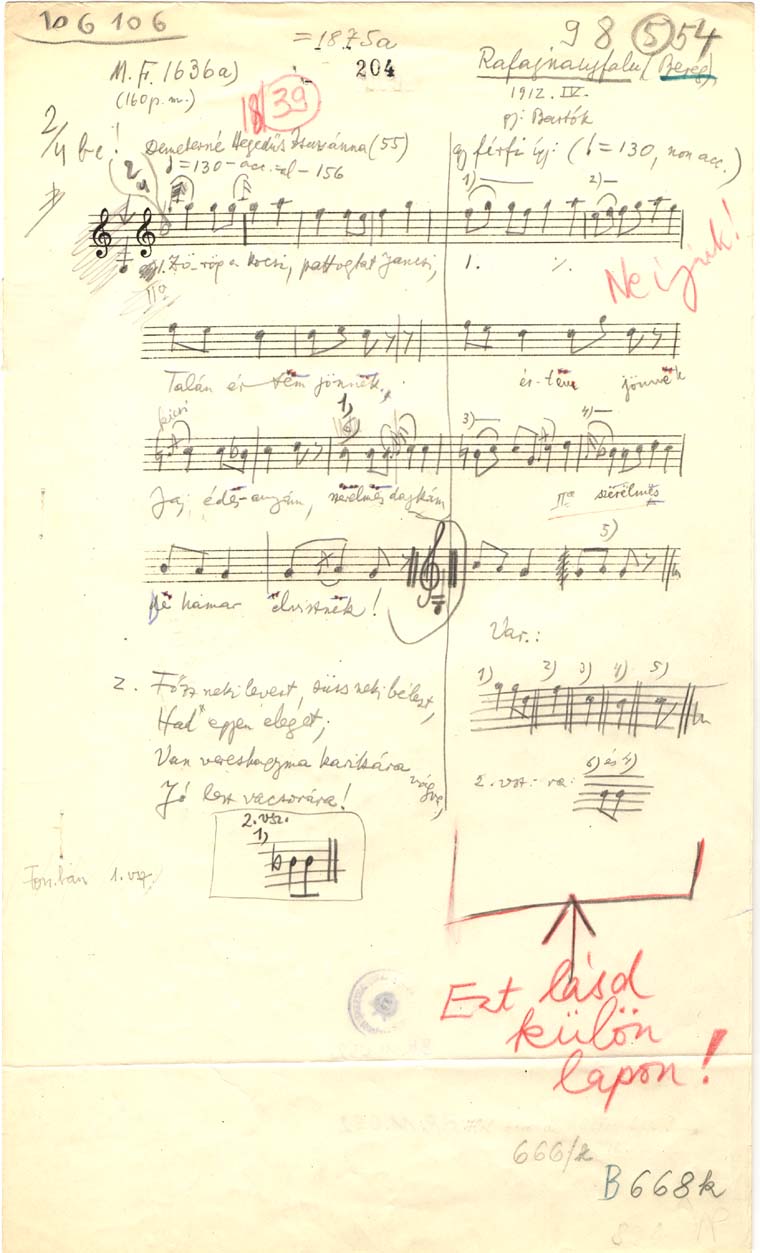
(5) The latest type of master sheets contain the material of the sound recordings made in 1936–38 in the studios of the Hungarian Radio. Organized by the Museum of Ethnography and sponsored by the Hungarian Academy of Sciences, this project brought up folk singers from the country to the capital in order to make good quality recordings of their music. Bartók participated both in the recording sessions and in the transcription of the material. His transcriptions represent his latest and most detailed notation of Hungarian folk music, with meticulous rendering of the rhythmic nuances and the rich ornamentation of the performance. Some of the transcriptions resulted in such a dense notation that it was necessary to provide a parallel notation only with the main rhythm and notes, as it were a skeleton of the melody, a form in which it can never be heard but which represents the most constant elements of it. Some of the transcriptions were published, some were copied by Bartók, or by his student and copyist, Jenő Deutsch on Lichtpause (tissue master) paper and a limited edition made of the latter was also circulated.[22] The master sheets consist of the pages of these copies pasted on cardboard. (Facsimile no. 13 represents one of these master sheets in Jenő Deutsch’s handwriting.)
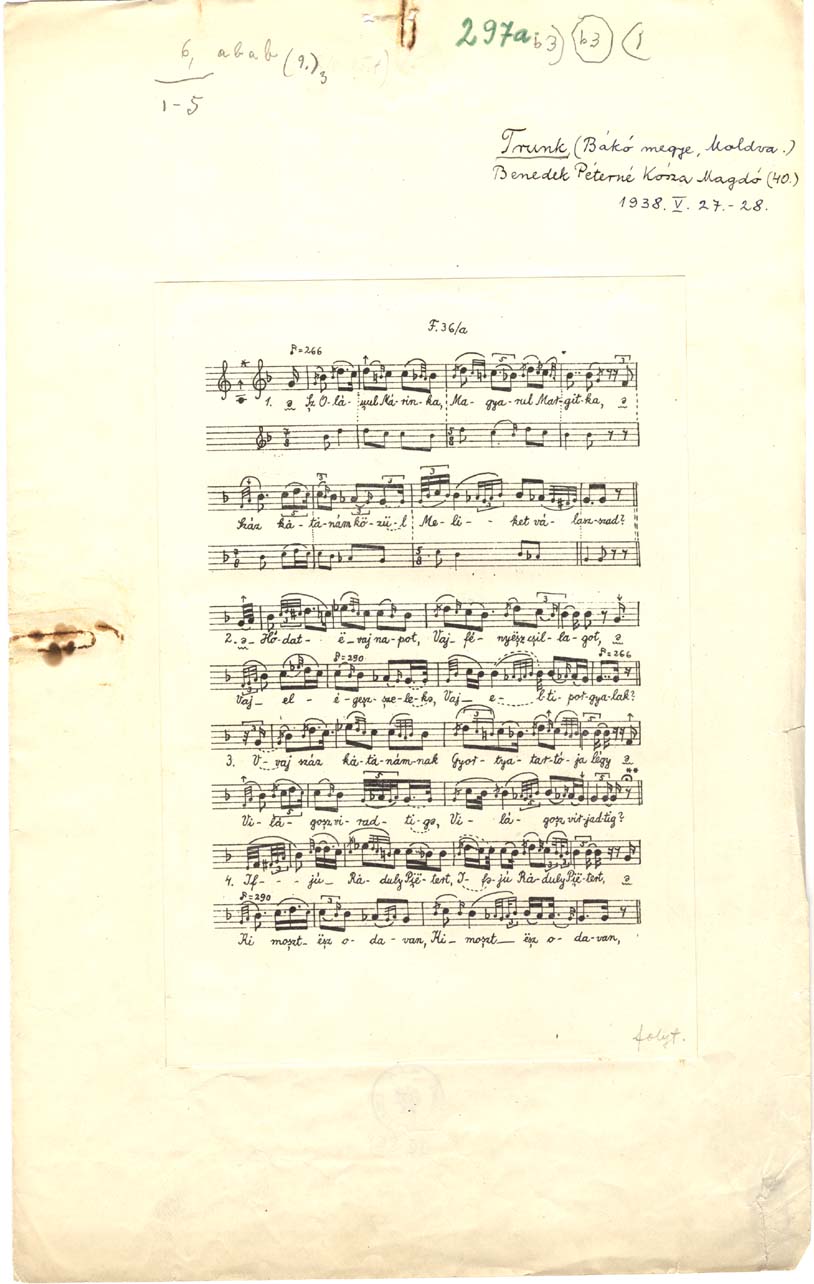
The master sheets of Bartók’s Hungarian collection are part of the so called Bartók-Rend [Bartók System]. Bartók developed his system during the 1910s through which he discovered the three major stylistic layers, the old (Class A), the new (Class B) and the mixed (Class C) groups of Hungarian folk music, each with several subgroups that are formed by shared characteristics. The Bartók-Rend is a collection of about 13,000 melodies, arranged according to this system. Bartók prepared this material, containing besides his own collection of about 2800 melodies, every Hungarian folk song collected until 1938, for publication at the Hungarian Academy of Sciences between 1934 and 1940. All types of master sheets occur in this collection.
A series of Bartók’s Romanian master sheets, bound in 28 volumes, are kept in the Budapest Bartók Archives. The larger part of them is the material published in Rumanian Folk Music: the instrumental melodies in seven volumes, the motivic dances in three volumes, and the vocal melodies in eight volumes. The material of the Maramureş volume is collected in four volumes, the master sheets of the Colindebook in further four, while some discarded or unused record cards, belonging in part to the Bihor study, are bound in two further volumes. Thus Bartók’s entire Romanian collection can be examined here. All the master sheets belong to the second and fourth type—that is, they were prepared during the 1910s and corrected in the 1930s.
At the time of the first edition of this catalog, only a few flawed or discarded master sheets of the Slovak collection were kept at the Budapest Bartók Archives. Today the entire collection is available for study in photocopies of the material found in Slovakia and in possession of Peter Bartók. The master sheets of the transcribed Arab melodies are also kept in the Archives. The master sheets of the Ruthenian collection belong to the Museum of Ethnography in Budapest. All of the above represent the second type of master sheet.
Printed sources. It was of utmost importance for Bartók to see his systematically arranged collections in print in a timely manner, mainly to prevent duplicate efforts and direct new collectors to unexplored territories, but also to facilitate the comparison with the already available material. For this purpose, he spared no efforts and expenses. Yet, very few of his collections appeared in print during his lifetime.
Bartók prepared for publication almost his entire collection of roughly ten thousand melodies, with the negligible exception of about one hundred Ruthenian melodies, and about 130–40 Arab melodies. However, the years between the two wars were not favorable for this kind of undertaking. There was always some hindrance in the way of publications. Money was running out, or the public showed little interest. The publishers postponed publication forever, as the Matica Slovenská with the Slovak collection, or simply withdrew their offers, as the New York Public Library did to publish the Rumanian Folk Music and the Turkish Folk Music of Asia Minor. In effect, Bartók succeeded in seeing only about 1,600 melodies from his collections in print: 371 melodies in the Cântace poporale româneşti din Comitatul Bihor (Bucharest, 1913); 378 melodies in the Volksmusik der Rumänen von Maramureş (Munich, 1923); 65 melodies in “Die Volksmusik der Araber von Biskra und Umgebung” (Zeitschrift für Musikwissenschaft, 1920); 484 melodies in the Melodien der rumänischen Colinde (Weihnachtslieder) (Vienna, 1935), and 28 melodies in the mimeographed booklet in his handwriting entitled the Musique paysanne serbe et bulgare du Banat(Budapest, 1935)[23]—that is, altogether 1326 melodies. In addition, he published about 300 Hungarian melodies in the Erdélyi magyarság (Budapest, 1923), in The Hungarian Folk Song (Budapest, 1924), and in his shorter essays.
Since Bartók’s death, a major part of the unpublished collections has appeared in print. The first volume of Slovenské Ľudové Piesne appeared in 1959 and was followed by the second in 1970; the three-volume Rumanian Folk Music was published in 1967, the Turkish collection in two parallel editions in 1976.[24] The situation of the Hungarian collection is different. Bartók considered his own collection part of the entire Hungarian collection and he incorporated it in the collective material to which every Hungarian ethnomusicologist contributed. He never considered the publishing of his own material separately. For his book The Hungarian Folk Music, he compiled the examples from the collective repository of songs. During his last years in Hungary before his emigration, between 1934 and 1940, he was preparing the entire Hungarian material collected until 1938 for print. After the war, collecting activities continued with renewed effort and the material expanded by leaps and bounds. Its publication, A magyar népzene tára (Corpus musicae popularis Hungaricae), which began in 1951 and continues today, follows different principles than that of Bartók’s conception but includes the items of his collection.[25] The master sheets of the Bartók System, however, are kept, in the original order as Bartók left them behind, in custody of the Folk Music Archives of the Institute for Musicology in Budapest. Since it is his major ethnomusicological work, it can deservedly claim the attention of scholars studying his music. This need was met when the first part of this collection—416 melodies and their variants—was published with an exhaustive essay presenting the history and the construction of the Bartók System.[26] In 2004, the entire collection was digitized and it is available today on the web site of the Institute for Musicology of the Research Centre for the Humanities.[27]
About the sound recordings
There is no need to emphasize the inestimable research and esthetic value of the historic recordings presented here. They embody the irreplaceable documents of melodies transmitted exclusively by oral tradition from a bygone era, from the time of the beginnings of recorded sound, before the wide permeation of mass media. Yet, one has to keep in mind that for Bartók, the recording did not represent the only or definite document of a melody. Rather, he considered it—similar to a specific interpretation of a piece of art music—as the rendition of a certain singer at a particular time with the unavoidable eventuality and imperfections of a single performance. For this reason, he upheld the absolute necessity of notating the melodies in the field, based on a hearing of several performances, because these notes allowed him to correct the errors of the recorded version. At the early times of his collecting activity, he regarded even the ornamentation and the deviation from regular rhythms as eventualities and left most of them out of his transcriptions of the recordings. Later, however, he recognized the importance of the ornamental notes, the gliding of the voice, and peculiarities of intonation and rhythm as characteristics of folk performances and revised his transcriptions to reflect these finest details.
It is no surprise, then, that some of the musical notations found in the catalog do not correspond perfectly to the pertinent sound recording. The following discrepancies are typical:
(1) Errors, such as wrong notes, rhythms or skipped measures in the performance: in the recording of L 194, the performer sang the second part of the melody in both stanzas so much out of tune that Bartók was unable to determine the pitch of the final tone. He could reconstruct, however, the second part of the melody from his field notations. In the recording of L 4, the beginning of the melody is not only out of tune but its rhythm is also uncharacteristically hurried. Bartók noted on the transcription: “it is too fast and the intonation is bad in the recording.”
(2) The octave break is a rather frequent occurrence in performances: if the singer (usually a woman) started the song on too high or too low a note, she was compelled to transpose those parts of the melody which were out of the range of her voice. To mention two examples: in L 18, the second and third phrases of the melody are partly sung an octave lower than they should be; while in L 238, the last line is transposed an octave higher. In the remarks on the sound recordings, every such occurrence is noted.
(3) Differences of rhythm, most typically dotted rhythm (mainly short–long) as against even rhythm: in L 18, for example, the two eighth notes before the final two quarter notes of the first three melody-lines are notated as even eighth notes but are sung as a short–long pair of notes of slightly varying proportion.
(4) Occasionally, the text of the recording is different from what we know from the composition because Bartók opted to use the subsequent stanzas rather than the first, as in L 18, where he considered the second and third stanzas more appropriate for his purposes. At times he took the text from another song, as in L 239, where the melody, collected in Csík County, is coupled with the text of a close variant, also collected in that region.
(5) Sometimes the arrangement borrows portions of variant melodies of its theme. For the fifth number of the Eight Hungarian Folk Songs (L 170), for instance, Bartók chose a melody performed by a woman of Csíkvacsárcsi, but he replaced the fourth line with the corresponding line of another melody, heard in Csíkkarczfalva. The melody of L 190, on the other hand, utilizes portions of melodies collected at three different locations.
(6) In a number of cases, there were no recordings made of the melody that Bartók singled out for his compositions. Whenever available, the recordings of more or less close variants were substituted on our sound recordings in these cases. One such example is L 3 of which notations exist from at least seven different locations, along with two recordings, none of which is identical with the form appearing in the composition. Similarly, L 41 comes from Bartók’s field notation: this, however, is not the same as the two performances included in the recordings. One of them was collected by Béla Vikár, the other by Bartók, but five to six years after the composition was written.
The original medium of the recordings is the wax cylinder, impressed by mechanical means, with the capability of holding about three minutes of sound, that is, not more than two to three melodies. Most of the cylinders of Bartók’s collection are in the possession of the Budapest Museum of Ethnography. Since they are very brittle and sensitive to humidity, their preservation is directed toward proper storage and salvaging their content. The first preservation project of the original phonograph cylinders was carried out in the 1960s at the Folk Music Research Group of the Hungarian Academy of Sciences when Pál Sztanó transferred the sound onto reel-to-reel tapes and long playing records. The present digitization is the work of István Németh.
(Abridged version of the introduction in Folk Music in Bartók’s Compositions by Vera Lampert. ©2008 by Vera Lampert)
[1] Published by László Somfai, “Eine Erklärung Bartóks aus dem Jahre 1938,” Documenta Bartókiana 4, ed. Denijs Dille (Budapest: Akadémiai Kiadó, 1970) [henceforth: DocB/4], 163–64.
[2] See László Somfai, Béla Bartók: Composition, Concepts, and Autograph Sources (Berkeley: University of California Press, 1996), 297–320.
[3] Magyar Lant (Hungarian Lute), supplement to the issue of February 15, 1905. See its facsimile in DocB/4, 25–26.
[4] Zoltán Kodály, “A folklorista Bartók,” in Kodály, Visszatekintés: Összegyűjtött írások, beszédek, nyilatkozatok [Looking back: collected writings, talks, and statements], ed. Ferenc Bónis, v. 2 (Budapest: Zeneműkiadó, 1982), 451; cf. in English translation, “Bartók the Folklorist,” in The Selected Writings of Zoltán Kodály (Budapest: Corvina Press, 1974), 103.
[5] Béla Bartók, Hungarian Folk Music (London: Oxford University Press, 1931). Most recently as The Hungarian Folk Song, edited by Peter Bartók (Homosassa, Florida: Bartók Records, 2002).
[6] Denijs Dille, “Gerlice Puszta: ‘Mai bis November 1904’,” DocB/4, 15–40; Ferenc László, “Megjegyzések a Bartók-életrajz Dósa Lidi epizódjához” [Notes to the Lidi Dósa episode of the Bartók biography], in Bartók Béla: tanulmányok és tanúságok [Béla Bartók: studies and testimonies] (Bucharest: Kriterion, 1980), 9–22. See the English version of this article, “Bartók’s First Encounter with Folk Music,” The New Hungarian Quarterly 19, no. 72 (1978), 67–75.
[7] See Bartók’s remark in his letter to Wilhelmine Creel, published in Hungarian in János Demény, Bartók Béla levelei [Béla Bartók Letters] (Budapest: Zeneműkiadó, 1976), no. 1064: “I had much trouble with the second rondo. I wanted first to include a 3rd theme which later proved to be impracticable. (MS*** in the Budapest Bartók Archives). The melody was identified as no. 678 in the Slovenské Ľudové Piesne by Halsey Stevens in his unpublished essay about the sketches of the composition.
[8] Published and identified as no. 376 in the second volume of Rumanian Folk Music in László Somfai, Béla Bartók, 193.
[9] Benjamin Suchoff, Guide to the Mikrokosmos of Béla Bartók (Silver Spring, Maryland: Music Services Corporation of America, 1956). Published lately as Bartók’s Mikrokosmos: Genesis, Pedagogy, and Style (Lanham, Maryland: The Scarecrow Press, Inc., 2002).
[10] “Utolsó magyarországi interjú” [Last interview in Hungary], Magyar Nemzet, October 3, 1940. My translation.
[11] Zoltán Kodály, “A folklorista Bartók,” 451 and “Bartók the Folklorist,” 103. About the revised edition of the series see Vera Lampert, “A Bartók–Kodály Magyar népdalok második kiadása” [The second edition of the Hungarian Folk Songs by Bartók and Kodály], Zenetudományi dolgozatok (Budapest: MTA Zenetudományi Intézet, 2003), 275–84.
[12] Ferenc Bónis, “A ’Gyermekeknek’ című sorozat kihagyott darabjai” [The omitted pieces of the series For Children], Magyar Zene 6, no. 4 (1965), 347–56.
[13] “Observări despre muzica poporală românească,” Convorbiri Literare 48 (1914), 703–709; BÖI, 612, Essays, 196.
[14] No study determined yet the exact proportion between the recorded melodies and the melodies only notated on the spot. After leafing through Bartók’s publications of folk music, it is clear that the highest number of recorded melodies are among the instrumental pieces. The ratio is also different by nationality. Recordings were made of most of the Romanian melodies (93 per cent in the Romanian Folk Music), while in the first volume of Slovenské Ľudové Piesne, only about two third of the melodies were recorded with the phonograph. In the Hungarian Folk Music, the ratio is 5:3 between the recorded and notated melodies.
[15] Miért és hogyan gyűjtsünk népzenét?, Népszerű Zenefüzetek, 5 (Budapest: Somló Béla Kiadása, 1936); “Why and How Do We Collect Folk Music?” Essays, 19.
[16] Two more field books, the so-called Arab and Turkish books are in Peter Bart ó k’s possession. We based our description of the melody no. 301 partly on the Arab field book.
[17] “Observări despre muzica poporală românească,” Convorbiri Literare 48 (1914), 703–709; “Observations on Rumanian Folk Music,” BÖI, 613, Essays, 197. See note 15 above.
[18] This term, used even in our days by Hungarian scholars of folk music, was introduced by Béla Vikár in his paper “Élő nyelvemlékek” [Alive monuments of language], Ethnographia 12 (1901), 141.
[19] See Bartók’s earliest publications of folk music in the 1908 and 1909 issues of Ethnographia: “Székely balladák” [Székely ballads] (1908) and “Dunántúli balladák” [Transdanubian ballads] (1909).
[20] Musikblätter des Anbruch (1920); La Revue Musicale (1921).
[21] However, according to György Kerényi and Benjamin Rajeczky (“Über Bartóks Volksliedaufzeichnungen”, SM 5 (1963), 441–48) in these transcriptions “… ist der Typencharakter noch immer so ma β gebend, da β in Einzellfällen nicht das Phonogramm, sondern die aus Varianten zusammengestellte ideale Form mitgeteilt wird.” (The characteristics of the type are still so prevalent that in certain cases what can be seen is not [a transcription of] the recording but rather an ideal form based on several variants [of the melody].)
[22] Originally as Magyar népzenei gramofonfelvételek... [Gramophone recordings of Hungarian folk music] (Budapest, 1937) and as inserts to the so-called Pátria recordings. László Somfai published the complete material in the accompanying notes to the three-record set of Hungarian Folk Music: Gramophone Records with Bartók’s Transcriptions, (Budapest: Hungaroton, 1981), LPX 18058-60. See also P átria: Magyar népzenei gramofonfelvételek [Pátria: Gramophone recordings of Hungarian folk music ], CD-ROM, ed. Ferenc Sebő (Budapest: Fonó, 2001).
[23] See its facsimile reprint in: DocB/4, 221–44.
[24] Turkish Folk Music from Asia Minor, ed. Benjamin Suchoff (Princeton: Princeton University Press, 1976); Adnan A. Saygun, Béla Bartók’s Folk Music Research in Turkey, ed. László Vikár (Budapest: Akadémiai Kiadó, 1976). Most recently as Turkish Folk Music from Asia Minor, ed. Peter Bartók (Homosassa, Florida: Bartók Records, 2002).
[25] v. 1. Gyermekjátékok [Children’s games], v. 2. Jeles napok [Calendar customs], v. 3. Lakodalom [Wedding songs], v. 4. Párosítók [Pairing songs], v. 5. Siratók [Laments], v. 6–10. Népdaltípusok [Types of folk songs] 1–5 (Budapest: Akadémiai Kiadó, 1951–92 and Balassi Kiadó, 1992–97).
[26] Hungarian Folk Songs: Complete Edition. Vol. 1 (Class A-I, nos. 1–416), compiled by Béla Bartók; commissioned by the Hungarian Academy of Sciences from 1934 to 1940; ed. Sándor Kovács and Ferenc Sebő (Budapest: Akadémiai Kiadó, 1993).
[27] http://db.zti.hu/bartok/
